Five hundred and fifty kilometres off the coast of Costa Rica lies a small island that is literally the stuff of legends. Cocos Island, a National park and UNESCO World Heritage Site is steeped in pirate history. If the stories are true, some of the most famous pirates in history have used this remote land mass to hide their bounty. With over 200 waterfalls pouring out beside the coconut palms and over the sheer, volcanically forged cliff faces, it is believed that this ancient looking place inspired Michael Crichton’s book, Jurassic Park, and has also been suggested to be the inspiration behind Robert Louis Stevenson’s book, Treasure Island. But Cocos also has another secret. The waters surrounding the island are rich in nutrients fed by deep water counter currents. These nutrients provide an environment which attracts a broad spectrum of pelagic species including rays, dolphins, whales and, the reason most people go, sharks! On assignment in December, I spent seven days aboard the Undersea Hunter dive boat exploring this underwater lost world. The entire trip was one exciting and memorable moment after another leaving me wanting for more. However, there are two dives in particular that still remain clear in my mind and are telling examples of how wild Cocos still is.
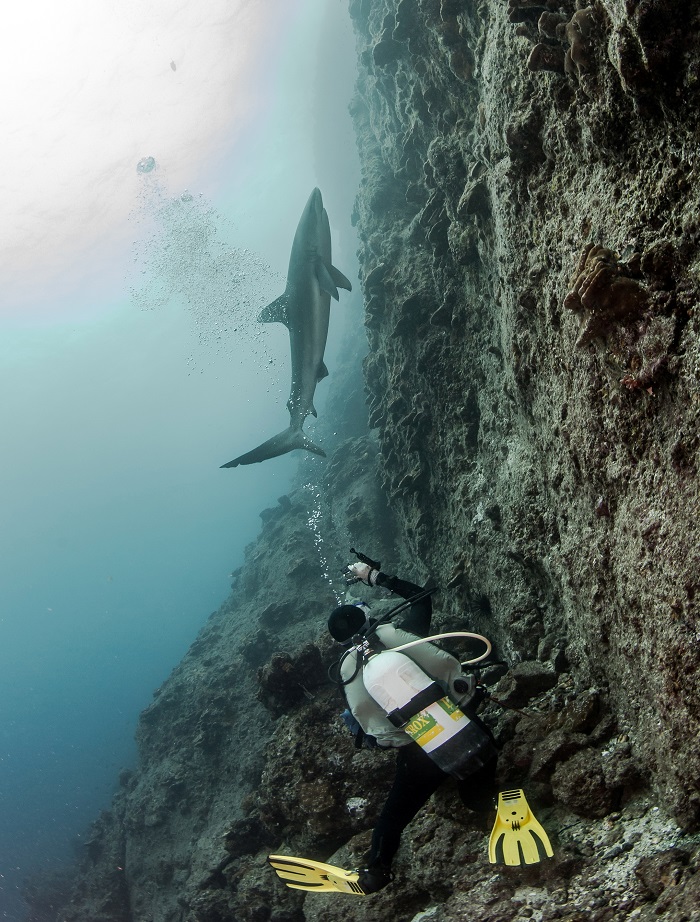
On day four of our trip, we visited Alcyone, an underwater sea mount discovered by Jacques-Yves Cousteau. We were told by our guide that this was one of Cousteau’s favourite sites, and we quickly discovered why. Upon arriving at the site the mooring buoy was found to be several meters underwater, pushed diagonally by the ripping current that passed through the area. Descending down the line, I was reminded of images from various television shows where the character is holding on to a telephone pole in a hurricane with their body blown perpendicular to the ground, flapping in the wind like a piece of cloth. I was quite certain that if I released the line, I wouldn’t be able to swim fast enough to reach it again. Hand over hand; we pulled ourselves down the 27 metre drop until we reached the top of the underwater sea mount. At the bottom, we slowly moved into the current towards the edge of the mountain top to get a better view. What I witnessed next was perhaps one of my most memorable dives in over 20 years of diving (3000+ dives). I heard the dolphins before I saw them, a pod of about eight to 10 bottlenose dolphins working in unison to corral a massive shoal of bait fish directly over us. It began slowly with several passes but quickly turned into a full-on assault. The noise and commotion caused by the bait ball quickly attracted a large school of hammerhead sharks to the area. The hammerheads joined in the hunt only for a brief period before being frightened off by an even larger school of oceanic black tip sharks. This was the first time I had seen this particular shark up close and was memorized by their speed and agility.
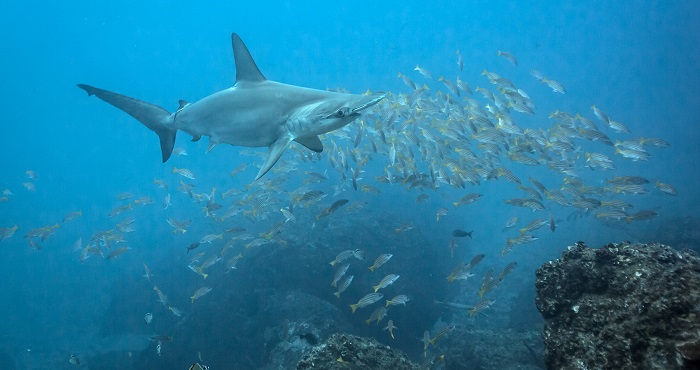
I have known since I was young that sharks were one of the oldest and most efficient predators on the planet but watching this scene unfold in front of me left no doubt in my mind. As the bait ball began to shrink several other participants showed to finish off the lingering shoal. A few bulky Galapagos sharks, some of the hammerheads that could be seen in the distance rejoined the hunt, the odd silky shark and many of the white tip reef sharks that were previously lounging on top of the sea mount were enticed to join the hunt. Looking at my dive computer, I realized it was already time to begin our ascent. In what seemed to be the blink of an eye, the dive was over and we headed reluctantly back to the boat still buzzing with the excitement over the spectacular scene we had just witnessed.
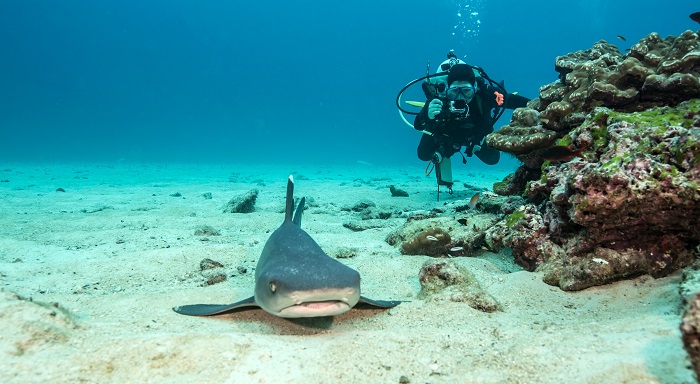
Our night dive was another unique experience that only the rich, pelagic environment around Cocos could offer. Upon arriving at the dive site on our first night dive, the moon had yet to come over the horizon so we were surrounded by sheer darkness. Like me, several others on the boat had a fair bit of experience in shark diving and were comfortable in the waters here. But it seemed that when it came to night diving, we were all a little reluctant to be the first ones in the water. So after a few minutes of hesitation, I pushed myself towards the edge of the boat, waited for the captain’s permission and rolled back into the black water below. Arriving near the sandy bottom, I could see several white tip reef sharks and large trevally cruising intently in and out of the coral patches looking for their next meal. Several small fish could also be seen tucked away, hiding motionless under the overhangs in the coral in fear of being spotted. As the rest of the group arrived, it appeared — the sharks were attracted to the lights and soon there were several hundred reef sharks swarming the coral below us.
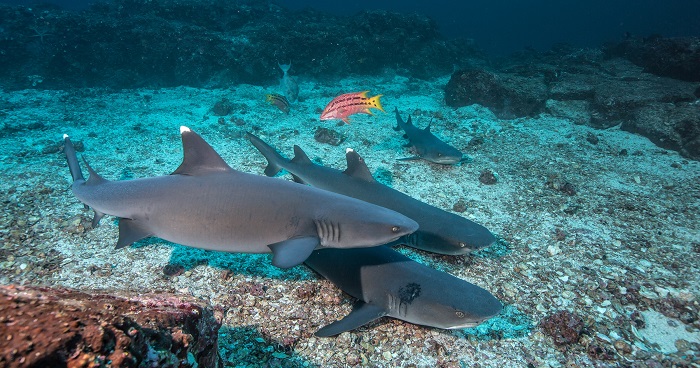
Occasionally one would find a meal and the swarm would turn into a frenzied ball with loud snapping and crunching sounds as the sharks tried to pile into the reef to get a, piece of the action. We followed on top of them watching the hunt. I moved away from the group in order to have less light interfering with my photos and planted myself in a spot with a good vantage point where I could capture the sharks as they filed through the reef. One of the reef sharks managed to capture a parrot fish and again the frenzy began but this time something else appeared out of the darkness. The first thing I noticed was the size. This shark was at least three times the size of the other reef sharks, and then I noticed the distinctive stripe pattern across the animals back. Tiger Shark! It came in quickly and circled once before moving off again into the darkness. I hastily headed back to the group in order to make our guide aware of what I just witnessed. Several others in the group saw me making the sign for tiger shark, and soon the majority were scanning the surroundings paying little attention to the hunting reef sharks below. Our group quickly became a tight formation as we searched for the animal I had just seen. Suddenly, a larger Galapagos shark very casually swam past us from behind and headed into the crowds of reef sharks. It quickly became obvious that this animal was looking for a meal and the reef sharks were on the menu. Within less than a minute of his arrival all of the reef sharks disappeared and our guide motioned that it might be a good time to end the dive. As we completed our safety stop, all lights were on the bottom watching the Galapagos shark circle, looking for a snack. When we surfaced, we were all once again thrilled and amazed with what had just witnessed but it was also obvious that we were all a little reluctant to be the last person in the water either.
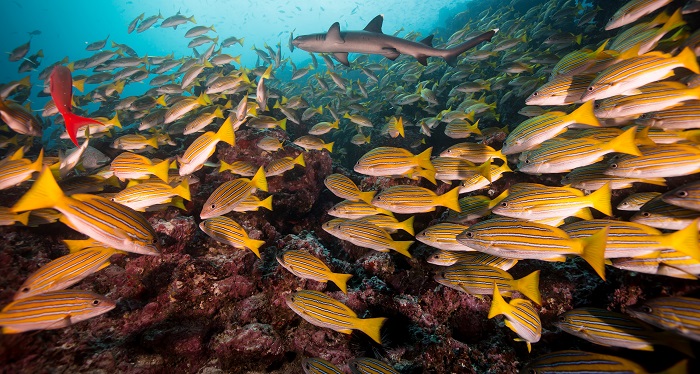
Cocos doesn’t have much for coral, the surface is generally quite rough and it rains more often than not. Underwater the visibility usually isn’t spectacular and the currents can be strong, even treacherous at times and the diving is difficult but it still remains as one of my favourite dive destinations. There are few places left in the world as wild as Cocos which give me a greater appreciation for what it is and what it represents.
Words + Photos By: Darryl MacDonald

